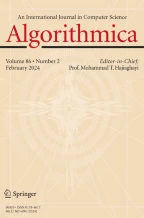Abstract
Tile self-assembly is a well-studied theoretical model of geometric computation based on nanoscale DNA-based molecular systems. Here, we study the two-handed tile self-assembly model or 2HAM at general temperatures, in contrast with prior study limited to small constant temperatures, leading to surprising results. We obtain constructions at larger (i.e., hotter) temperatures that disprove prior conjectures and break well-known bounds for low-temperature systems via new methods of temperature-encoded information. In particular, for all \(n \in \mathbb {N}\), we assemble \(n \times n\) squares using \(O(2^{\log ^*{n}})\) tile types, thus breaking the well-known information theoretic lower bound of Rothemund and Winfree. Using this construction, we then show how to use the temperature to encode general shapes and construct them at scale with \(O(2^{\log ^*{K}})\) tiles, where K denotes the Kolmogorov complexity of the target shape. Following, we refute a long-held conjecture by showing how to use temperature to construct \(n \times O(1)\) rectangles using only \(O(\log {n}/\log \log {n})\) tile types. We also give two small systems to generate nanorulers of varying length based solely on varying the system temperature. These results constitute the first real demonstration of the power of high temperature systems for tile assembly in the 2HAM. This leads to several directions for future explorations which we discuss in the conclusion.
Similar content being viewed by others
Notes
The function \(\log ^*{n}\) is the iterated logarithm: the number of times the logarithm must be repeatedly applied, beginning with n, until a value of less than 1 is reached.
The term thin refers to the constant height of the rectangle.
References
Adleman, L., Cheng, Q., Goel, A., Huang, M.D.: Running time and program size for self-assembled squares. In: Proceedings of the 33rd ACM Symposium on Theory of Computing, STOC’01, pp. 740–748 (2001)
Bryans, N., Chiniforooshan, E., Doty, D., Kari, L., Seki, S.: The power of nondeterminism in self-assembly. In: Proceedings of the 22nd ACM–SIAM Symposium on Discrete Algorithms, SODA’11, pp. 590–602. SIAM (2011)
Cannon, S., Demaine, E.D., Demaine, M.L., Eisenstat, S., Patitz, M.J., Schweller, R., Summers, S.M., Winslow, A.: Two hands are better than one (up to constant factors). In: Proceedings of 30th International Symposium on Theory Aspects of Computing Science, STACS’13, pp. 172–184 (2013)
Chalk, C., Luchsinger, A., Schweller, R., Wylie, T.: Self-assembly of any shape with constant tile types using high temperature. In: Proceedings of the 26th Annual European Symposium on Algorithms, ESA’18 (2018)
Chen, H.L., Doty, D.: Parallelism and time in hierarchical self-assembly. In: Proceedings of the 23rd ACM–SIAM Symposium on Discrete Algorithms, SODA’12, pp. 1163–1182. SIAM (2012)
Chen, H.L., Doty, D., Seki, S.: Program size and temperature in self-assembly. Algorithmica 72(3), 884–899 (2015)
Cheng, Q., Aggarwal, G., Goldwasser, M.H., Kao, M.Y., Schweller, R.T., de Espanés, P.M.: Complexities for generalized models of self-assembly. SIAM J. Comput. 34, 1493–1515 (2005)
Demaine, E., Patitz, M., Rogers, T., Schweller, R., Summers, S.M., Woods, D.: The two-handed tile assembly model is not intrinsically universal. In: Proceedings of the 40th International Colloquium on Automata, Languages and Programming (ICALP 2013) (2013)
Doty, D.: Personal communication
Doty, D., Lutz, J.H., Patitz, M.J., Schweller, R., Summers, S.M., Woods, D.: The tile assembly model is intrinsically universal. In: Proceedings of the 53rd IEEE Conference on Foundations of Computer Science (FOCS), pp. 302–310 (2012)
Doty, D., Patitz, M.J., Summers, S.M.: Limitations of self-assembly at temperature one. In: Proceedings of 15th International Conference on DNA Computing and Molecular Programming (DNA’09), LNCS, vol. 5877, pp. 35–44. Springer, Berlin (2009)
Evans, C.: Crystals that count! Physical principles and experimental investigations of DNA tile self-assembly. Ph.D. thesis, California Institute of Technology (2014)
Maňuch, J., Stacho, L., Stoll, C.: Two lower bounds for self-assemblies at temperature 1. J. Comput. Biol. 16(6), 841–852 (2010)
Meunier, P.E.: The self-assembly of paths and squares at temperature 1. Tech. rep., arXiv (2013)
Meunier, P.E., Patitz, M.J., Summers, S.M., Theyssier, G., Woods, D.: Intrinsic universality in tile self-assembly requires cooperation. In: Proceedings of the 25th Symposium on Discrete Algorithms (SODA), pp. 752–771 (2014)
Rothemund, P.W.K., Winfree, E.: The program-size complexity of self-assembled squares (extended abstract). In: Proceedings of the 32nd ACM Symposium on Theory of Computing (STOC), pp. 459–468 (2000)
Schulman, R., Winfree, E.: Programmable control of nucleation for algorithmic self-assembly. SIAM J. Comput. 39(4), 1581–1616 (2009)
Schweller, R.T., Winslow, A., Wylie, T.: Complexities for high-temperature two-handed tile self-assembly. In: 23rd International Conference on Computing and Molecular Programming, DNA’17, pp. 98–109 (2017). https://doi.org/10.1007/978-3-319-66799-7_7
Seeman, N.C.: Nucleic-acid junctions and lattices. J. Theor. Biol. 99, 237–247 (1982)
Seki, S., Ukuno, Y.: On the behavior of tile assembly system at high temperatures. Computability 2(2), 107–124 (2013)
Soloveichik, D., Winfree, E.: Complexity of self-assembled shapes. SIAM J. Comput. 36(6), 1544–1569 (2007)
Summers, S.M.: Reducing tile complexity for the self-assembly of scaled shapes through temperature programming. Algorithmica 63(1), 117–136 (2012)
Winfree, E.: Algorithmic Self-Assembly of DNA. Ph.D. thesis, California Institute of Technology (1998)
Woods, D.: Intrinsic universality and the computational power of self-assembly. Philos. Trans. R. Soc. A (2015). https://doi.org/10.1098/rsta.2014.0214
Author information
Authors and Affiliations
Corresponding author
Additional information
Publisher's Note
Springer Nature remains neutral with regard to jurisdictional claims in published maps and institutional affiliations.
This research was supported in part by National Science Foundation Grants CCF-1555626 and CCF-1817602.
Rights and permissions
About this article
Cite this article
Schweller, R., Winslow, A. & Wylie, T. Nearly Constant Tile Complexity for any Shape in Two-Handed Tile Assembly. Algorithmica 81, 3114–3135 (2019). https://doi.org/10.1007/s00453-019-00573-w
Received:
Accepted:
Published:
Issue Date:
DOI: https://doi.org/10.1007/s00453-019-00573-w
